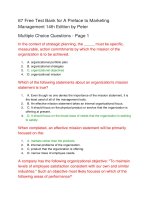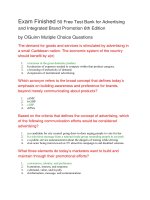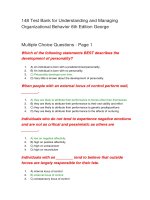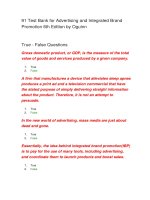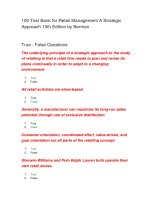Test bank for families and their social worlds 2nd edition by seccombe
Bạn đang xem bản rút gọn của tài liệu. Xem và tải ngay bản đầy đủ của tài liệu tại đây (82.29 KB, 11 trang )
Full file at this full document at
Chapter 1
Families and the Sociological Imagination
1.1 Multiple Choice Questions
1) Your family has a special friend that you are very close to, and call “Auntie
Marge,” even though she is not related to you. You invite her to many family
functions, and share many traditions together. Marge is an example of a/an:
A) domestic partner B) fictive kin C) human agency D) family of orientation E)
family of procreation
Answer: B
Diff: 2 Page Ref: 5
2) Relationships by blood, marriage, or affection, in which members may
cooperate economically, may care for any children, and may consider their
identity to be intimately connected to the larger group define a/an:
A) domestic partner B) fictive kin C) empirical relationship D) family E)
quantitative method
Answer: D
Diff: 1 Page Ref: 5
3) Which of the following best summarizes the attitudes of U.S. high school
seniors towards marriage and family?
A) Both boys and girls believe that a good marriage and family life are
extremely important; however, the percentage that thinks so has declined
since the early 1980s.
B) Most boys think that cohabiting before marriage is a good idea, but most
girls do not.
C) Teenagers are more likely to accept divorce, cohabitation, singlehood, and
being childfree as legitimate lifestyles, while at the same time also believing
that marriage, children, and a strong family life are important goals.
D) Over two-thirds of boys and girls believe that most people will have fuller
and happier lives if they choose legal marriage rather than staying single or
cohabiting.
E) Overwhelmingly, teenagers disapprove of divorce.
Answer: C
Diff: 3 Page Ref: 7
4) An organized pattern of social relationships and social institutions that
together form the basis of society is called:
A) the sociological imagination
B) social structure
C) comparative perspective
D) human agency
E) family
Answer: B
Diff: 2 Page Ref: 8
1
Copyright © 2012 Pearson Education, Inc. All rights reserved.
Full file at this full document at
5) C. Wright Mills stressed the importance of understanding the relationship
between individuals and the society in which they live because many of our
personal issues or problems are shaped by social forces. He was referring to
something called:
A) the sociological imagination
B) family
C) fictive kin
D) universal programs
E) conflict theory
Answer: A
Diff: 2 Page Ref: 9
6) When one family is uninsured, we are tempted to see it as a private
problem; however, when 50 million people are uninsured, it is really a social
problem. This is the point of:
A) a focus group
B) the sociological imagination
C) domestic partnerships
D) systems theory
E) micro theories
Answer: B
Diff: 2 Page Ref: 9
7) Brandon traveled to Mexico recently and made fun of the way the poor
families lived. ”Geez, don’t they know that they should do things like we do
here in America? Everyone knows our way is best.” This is an example of:
A) feminist theory
B) a conservative perspective
C) ethnocentrism
D) the sociological imagination
E) liberal perspective
Answer: C
Diff: 3 Page Ref: 10
8) ________ is a method that answers questions through a systematic
collection and analysis of data, including description and a determination of
cause and effect.
A) Theory B) Comparative perspective C) Family systems theory D) The
means-tested approach E) The empirical approach
Answer: E
Diff: 2 Page Ref: 10-11
9) As illustrated in World Map 1.1, a comparative perspective reveals that the
U.S.:
A) has one of the lowest infant mortality rates in the developed world
B) has an infant mortality rate similar to Canada, France, and England
C) has among the highest infant mortality rates in the developed world
D) can show other developed and developing countries how to lower their
infant mortality rates
E) has primarily universal programs to help combat infant mortality
2
Copyright © 2012 Pearson Education, Inc. All rights reserved.
Full file at this full document at
Answer: C
Diff: 2 Page Ref: 12-13
10) Adrian is a researcher doing a detailed study about attitudes and opinions
people have about being childfree. She wants detailed information from each
person. Which method would be best to use?
A) in-depth interview B) experiment C) observation D) secondary analysis E)
survey
Answer: A
Diff: 2 Page Ref: 14
11) What are the advantages and disadvantages of an experiment?
A) advantage: good for gathering information about issues that are not
directly observed; disadvantage: because the data were collected for another
purpose, the researcher cannot control what variables were included
B) advantage: good for exploratory and descriptive study in a natural setting;
disadvantage: a potential for a low response rate
C) advantage: group interaction may produce more valuable insights than
individual surveys; disadvantage: research must balance roles of participant
and observer
D) advantage: saves the expense and time of original data collection;
disadvantage: replication of research is difficult
E) advantage: provides greatest opportunity to assess cause and effect;
disadvantage: the setting may have an artificial quality about it
Answer: E
Diff: 3 Page Ref: 14
12) Jake is analyzing some data collected by the Census Bureau for his senior
project. What type of research method is he using?
A) experiment B) secondary analysis C) survey D) in-depth interview E) focus
group
Answer: B
Diff: 2 Page Ref: 14
13) Macro theories represent a general framework that focuses on:
A) personal dynamics and face-to-face interaction
B) the social interaction between family and members of other groups, and is
concerned with the meanings and interpretations that people have
C) the family into which you were born
D) societal patterns
E) other societies around the world or other historical periods to see how
others organize their social life and respond to its challenges
Answer: D
Diff: 2 Page Ref: 15
14) This theoretical perspective emphasizes issues surrounding social
inequality, power, and social change:
A) developmental theory
B) structural functionalist theory
C) conflict theory
3
Copyright © 2012 Pearson Education, Inc. All rights reserved.
Full file at this full document at
D) micro theory
E) family systems theory
Answer: C
Diff: 2 Page Ref: 16
15) Which theory is an example of a micro theory?
A) structural functionalist theory
B) conflict theory
C) feminist theory
D) family systems theory
E) empirical theory
Answer: D
Diff: 1 Page Ref: 17
16) Structural functionalist theory focuses on:
A) the social interaction between family members and other groups and is
concerned with the meanings and interpretations that people have
B) gender as the central concept for explaining family structures and family
dynamics
C) collecting data that can be measured numerically
D) the distinct stages of families and family members with their set of tasks,
roles, and responsibilities
E) all social institutions, including the family, that exist to fill a need in society
Answer: E
Diff: 2 Page Ref: 16
17) A number of changes in families have taken place over the past several
decades. These changes include:
A) both men and women are postponing the age of marriage
B) the percentage of persons who have never married has increased
significantly
C) the divorce rate has increased
D) Blacks are the largest minority group in the United States
E) the teenage birthrate is increasing rapidly, especially among Blacks
Answer: A
Diff: 2 Page Ref: 18
18) There are several different perspectives of family change. Shane believes
that the changing economic structure, such as through a loss of high-paying
manufacturing jobs or an erosion of the minimum wage, leads to changing
family and gendered roles, which ultimately leads to an underclass with
extraordinary challenges facing poor children. Shane represents which
perspective?
A) conservative B) liberal C) neo-con D) feminist E) developmental
Answer: B
Diff: 2 Page Ref: 20-21
19) The feminist perspective:
A) has nothing in common with the conservative perspective
4
Copyright © 2012 Pearson Education, Inc. All rights reserved.
Full file at this full document at
B) attributes the difficulties children face to sexist parenting practices in the
home and in the schools
C) has fallen out of fashion in the 21st century
D) suggests that children face problems because of a lack of cooperation
between the community, family, and employment to improve the quality of
life
E) believes that gross cultural and moral weakening contributes to father
absence and family disorganization through divorce or illegitimacy
Answer: D
Diff: 2 Page Ref: 20-21
20) Compared to other developing nations, the U.S. has a ________ national
family policy.
A) strong B) weak C) compassionate D) aggressive E) innovative
Answer: B
Diff: 1 Page Ref: 22
21) A welfare program like Temporary Assistance for Needy Families (TANF) is
an example of what type of social program?
A) universal B) focus group C) means-tested D) Maasai E) structural
Answer: C
Diff: 2 Page Ref: 22
22) Jenna and Roberto are debating how the U.S. deals with family policies.
Help them out. How does the U.S. compare with other developed nations with
respect to family policy?
A) The U.S. is the only developed country without universal health insurance,
paid maternity leaves, or family/child allowances.
B) The U.S. tends to have universal programs, whereas other developing
countries tend to rely on selective programs.
C) Programs like the fire department, parks, and public schools tend to be
means-tested in the U.S., unlike other countries.
D) Only Germany, Japan, Italy, and the U.S. fail to offer national health
insurance.
E) People in the U.S. tend to think more collectively and support more
progressive taxation.
Answer: A
Diff: 3 Page Ref: 22-24
23) Carla’s husband recently left her and their three children for another
woman. He pays no child support, she has few job skills, and is destitute.
Therefore she turns to the principal cash welfare program, which is called:
A) food stamps
B) Social Security
C) social structure program
D) Temporary Assistance for Needy Families
E) universal cash
Answer: D
Diff: 2 Page Ref: 24-26
5
Copyright © 2012 Pearson Education, Inc. All rights reserved.
Full file at this full document at
24) A ________ is a major sphere of social life, with a set of beliefs and rules
that are organized to meet basic human needs.
A) sociological imagination B) universal program C) selective program D) lifecourse E) social institution
Answer: E
Diff: 2 Page Ref: 26-27
25) You, your siblings, and your parents comprise your:
A) family of orientation B) fictive kin C) family of procreation D) domestic
partners E) human agency
Answer: A
Diff: 1 Page Ref: 27
26) You, your spouse, and your children comprise your:
A) family of orientation B) resiliency C) family of procreation D) domestic
partners E) human agency
Answer: C
Diff: 1 Page Ref: 27
27) There are five (5) themes of this textbook. Which is NOT one of them?
A) Families are both a public social institution and a private personal
relationship.
B) Social inequality has a powerful influence on family life.
C) Human agency interferes with family change.
D) Family policies reflect historical, cultural, political, and social factors.
E) Understanding families in the U.S. requires a comparative perspective.
Answer: C
Diff: 2 Page Ref: 27-34
28) How does the ideology of “family“ shape perceptions of immigrant
children, according to researcher Karen Pyke in the feature box?
A) Immigrant parents and their children become closer as they all try to
act ”American.”
B) The Mexican families that she interviewed felt that the circumstances
surrounding parents‘ immigration, particularly whether their immigration was
legal or illegal, influences how they socialize their sons more so than their
daughters.
C) Parents watch television to observe how American families are supposed
to act, and practice their new model of parenthood with their children.
D) The cultural imagery of American families that children see on television is
often at odds with many immigrant families and the children denigrate their
own families as deficient.
E) Parents panic over the different expectations of families in the U.S.
compared to their homeland, and it causes them to be extremely strict with
their daughters.
Answer: D
Diff: 3 Page Ref: 28-29
29) The capacity to rebound from adversity, misfortune, trauma, or other
transitional crises and become strengthened and more resourceful is called:
6
Copyright © 2012 Pearson Education, Inc. All rights reserved.
Full file at this full document at
A) family protective factors
B) resiliency
C) human agency
D) family of orientation
E) symbolic interaction
Answer: B
Diff: 2 Page Ref: 30
30) Ju-long has overcome a difficult childhood to become a successful college
student, a kind friend, and a loving boyfriend. He was, and continues to be
insightful, independent, creative, and has a good sense of humor and a
strong sense of morality. Within the concept of resiliency, these are known
as:
A) ideological factors
B) family recovery factors
C) systems theoretical factors
D) individual-level protective factors
E) developmental factors
Answer: D
Diff: 2 Page Ref 30
1.2 True-False Questions
1) Your brother-in-law, Bob, is an example of fictive kin.
Answer: FALSE
Diff: 1 Page Ref: 5
2) A ”domestic partner“ is an unmarried couple, either heterosexual or
homosexual, in a long-term committed relationship.
Answer: TRUE
Diff: 1 Page Ref: 7
3) The sociological imagination reveals general patterns in what otherwise
might be thought of as simple random events.
Answer: TRUE
Diff: 1 Page Ref: 9
4) According to World Map 1.1, the United States has a low infant mortality
rate compared to other developing nations.
Answer: FALSE
Diff: 2 Page Ref: 12-13
5) Min is researching what happens to the health of families when they leave
Temporary Assistance for Needy Families (TANF). She is collecting data using
a series of focus groups, which will offer narrative description rather than
numbers. In other words, she is using quantitative methods.
Answer: FALSE
Diff: 2 Page Ref: 11
7
Copyright © 2012 Pearson Education, Inc. All rights reserved.
Full file at this full document at
6) Social exchange theory suggests that individuals are rational and their
behavior reflects an evaluation of costs and benefits.
Answer: TRUE
Diff: 1 Page Ref: 16
7) Matthew exemplifies a liberal perspective of family change, and therefore
argues that many of the changes in family structure, such as divorce or
unwed parenting, cause children to be at risk.
Answer: FALSE
Diff: 2 Page Ref: 20-21
8) Public education is an example of a means-tested program.
Answer: FALSE
Diff: 2 Page Ref: 22
9) Sales tax is an example of progressive taxation, but income tax is not.
Answer: FALSE
Diff: 2 Page Ref: 24
10) Your mom and dad are part of your family of orientation.
Answer: TRUE
Diff: 1 Page Ref: 27
11) Human agency refers to the impossibility of creating viable lives when
constrained or limited by social forces.
Answer: FALSE
Diff: 2 Page Ref: 27
12) A strengths perspective focuses on identifying, creating, mobilizing,
advocating, and respecting the resources, assets, wisdom, and knowledge
that every person and every family has to help ameliorate problems.
Answer: TRUE
Diff: 1 Page Ref: 29-30
13) Nathan Cabrera, in the feature box, shows the importance of community
factors in building resiliency.
Answer: TRUE
Diff: 1 Page Ref: 31-32
14) According to the feature box, adolescence among the Maasai lasts much
longer than in the U.S.—often until into their mid-twenties.
Answer: FALSE
Diff: 1 Page Ref: 35
15) It is important to study other cultures such as the Maasai because it
offers greater insight into our own culture.
Answer: TRUE
Diff: 1 Page Ref: 35
1.3 Short Answer/Fill in the Blank Questions
8
Copyright © 2012 Pearson Education, Inc. All rights reserved.
Full file at this full document at
1) ________ are relationships by blood, marriage, or affection, in which
members may cooperate economically, may care for any child, and may
consider their identity to be intimately connected to the larger group.
Answer: Families
Diff: 1 Page Ref: 5
2) ________ is the organized pattern of social relationships and social
institutions that together form the basis of society.
Answer: Social structure
Diff: 2 Page Ref: 8
3) ________ reveals general patterns in what otherwise might be thought of as
simple random events.
Answer: The sociological imagination
Diff: 2 Page Ref: 9
4) A ________ looks at other societies around the world or looks at a culture
historically to see how others organize their social life and respond to its
challenges.
Answer: comparative perspective
Diff: 2 Page Ref: 9
5) List the four goals of an empirical approach.
Answer: (1) describe some phenomena; (2) examine the factors that predict
or are associated with some phenomena; (3) explain cause-and-effect
relationships or provide insight into why certain events do or do not occur: (4)
understand the meanings attached to behavior or situations.
Diff: 3 Page Ref: 11
6) In ________ methods, the focus is on narrative description with words rather
than on numbers to analyze patterns and their underlying meanings.
Answer: qualitative
Diff: 2 Page Ref: 11
7) A theory is defined as:
Answer: a general framework, explanation, or tool to understand and
describe the real world.
Diff: 2 Page Ref: 15
8) Which theory examines how individuals‘ lives change as they pass through
the events in their lives, recognizing that many changes are socially produced
and shared among a cohort of people?
Answer: Life course perspective
Diff: 2 Page Ref: 17
9) The conservative perspective believes that:
Answer: gross cultural and moral weakening contributes to father absence,
which ultimately results in greater poverty, crime, drug use, and other social
problems.
9
Copyright © 2012 Pearson Education, Inc. All rights reserved.
Full file at this full document at
Diff: 2 Page Ref: 20
10) The U.S. tends to have ________ social policies and programs, whereas
other developed nations tend to have universal policies and programs.
Answer: selective
Diff: 2 Page Ref: 22
11) Progressive taxation refers to:
Answer: people who earn more pay a higher percentage of their income in
taxes.
Diff: 2 Page Ref: 24
12) A major sphere of social life, with a set of beliefs and rules that is
organized to meet some basic human need, such as the family, political, or
educational system is called a ________.
Answer: social institution
Diff: 2 Page Ref: 27
13) A family of orientation is defined as:
Answer: the family into which you were born.
Diff: 2 Page Ref: 27
14) List the five themes of the text:
Answer: (1) Families are both a public social institution and a private personal
relationship; (2) Social inequality has a powerful influence on family life; (3)
An expanded strengths-based perspective can improve family resiliency; (4)
Family policies reflect historical, cultural, political, and social factors; (5)
Understanding families in the U.S. requires a comparative perspective.
Diff: 3: Page Ref: 26-34
15) List the four factors discussed in your text that promote resiliency.
Answer: (1) individual-level protective factors; (2) family protective and
recovery factors; (3) community strengths; (4) structural-level conditions.
Diff: 3: Page Ref: 30-32
1.4 Essay Questions
1) Define family, and explain why definitions are important.
Page Ref: 5-8
2) Explain what we mean by the sociological imagination, and elaborate on
its two primary components.
Page Ref: 8-13
3) Describe the six research methods presented in the text, outlining their
advantages and disadvantages.
Page Ref: 11-15
10
Copyright © 2012 Pearson Education, Inc. All rights reserved.
Full file at this full document at
4) Define ”theory.” List and briefly describe the seven theories that are
common in the study of families.
Page Ref: 15-17
5) Compare and contrast the U.S. to other developed countries with respect
to family policy. Give examples.
Page Ref: 22-26
6) List the five themes of this textbook and choose two to describe in depth.
Page Ref: 26-34
7) Compare and contrast adolescence among the Maasai with adolescence in
the U.S. Why is this comparative approach important?
Page Ref: 33-35
11
Copyright © 2012 Pearson Education, Inc. All rights reserved.
